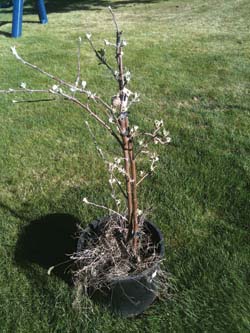Washington Fruit and Produce Company planted alyssum between the rows of this new orchard to attract syrphid flies, which are good predators of woolly apple aphid.
 Dain Craver’s plan to produce potted apple trees to sell to city residents was almost derailed by a bad infestation of woolly apple aphids.
Dain Craver’s plan to produce potted apple trees to sell to city residents was almost derailed by a bad infestation of woolly apple aphids.
Craver, an organic orchardist at Royal City, Washington, has more than 2,000 trees growing in five-gallon pots. The trees are on Budagovsky 9 rootstocks and double budded with Gala and Fuji, which are being intertwined as they grow. He planted them three years ago, and last year noticed that some of them were infested with woolly apple aphids around the roots.
There is no organic product that can be applied to control the pest, and releases of the beneficial insects lacewings, ladybugs, and praying mantis had no apparent effect.
“You could just pull the tree out of the pot, and it would be white with woolly apple aphid,” he said. “We were going to cull the trees out. I didn’t want to sell a tree that had woolly apple aphid.”
But as he examined the trees, he realized that he’d have hardly any trees left to sell. He recalled seeing results of research by Dr. Elizabeth Beers, entomologist at Washington State University, showing that planting alyssum could help attract syrphid flies (from the insect family Syrphidae), which are good predators of woolly apple aphid. He ordered 25 pounds of alyssum seed for about $4 to $5 a pound from a company in Texas, and planted seed in the pots around the trees. The alyssum grew well and took over the entire pots.
Sure enough, syrphid flies, which feed on nectar, were attracted to the vibrant white flowers, and the young syrphid fly larvae preyed on the woolly apple aphids. “It knocked the population down drastically,” Craver said. “I was really encouraged by the results.”
Not repelled
Craver said syrphid flies don’t seem to hesitate to get into the cottony covering of the woolly apple aphids, whereas lacewing and ladybug larvae seem repelled by the white fuzz. The syrphid flies lay their eggs on the aphids, and the young larvae that hatch from the eggs kill the aphids, disrupting their life cycle.
When he started growing the potted trees, he put regular flower seeds in the pots for aesthetic reasons, but stopped because the flowers were robbing the trees of nutrients and water. He thinks the alyssum has minimal negative impact on the trees, yet still looks attractive. The alyssum thrived all season long. He was hoping it would grow back this spring, but had some seed left to plant if not.
“I’m…excited about it,” he said. “That would be a great way to send the tree off to people, and it will help with any chance of lingering woolly apple aphid.”
He plans to sell the trees online and start promoting them in cities like Seattle and Portland next fall. After experimenting with different varieties for his certified organic potted trees, he settled on a combination of Gala and Fuji because the Gala apples mature early and are easy to tell apart from the Fuji.
He thinks they will be perfect for people who live in condominiums. Each tree will have about five or six apples, and will come with instructions on how to blossom thin and take care of it, and a small irrigation meter that indicates whether the soil is wet or dry.
Every tree will have an identifying number, and if the owners have any problems, they’ll be encouraged to take a picture of the tree and e-mail it to Craver for diagnosis.
Craver is so impressed with the effects of the alyssum that he plans to plant some of his remaining seed in the ground in his orchard. In blocks where he has rill irrigation, he will plant it at the ends of the rows where there are sprinklers and the flowers won’t be destroyed by the in-row tiller.
His goal for next year is to convert all his rill systems to sprinklers with the help of an EQIP (Environmental Quality Incentive Program) grant, which will enable him to plant alyssum between the tree rows with white clover. Craver said the clover stands up to being driven over by tractors, but it remains to be seen how well the alyssum will fare. He sprays only about four times during the early season, but then makes about 10 to 12 applications of calcium.
New orchard
Washington Fruit and Produce Company planted alyssum seeds down the middle of every alley in a 20-acre planting of apples established a year ago. Fred Plath, a company partner, said he read about Beers’s research in the Good Fruit Grower and planted alyssum with the idea that it would attract syrphid flies and keep woolly apple aphid at bay as the trees grow. The alyssum bloomed throughout the season last year and came back after mowing, although it was not mowed too low.
Plath said he was hoping the alyssum would come back this year. “There’s billions of seeds out there for this year, and we hope they germinate and everything works all right.”

Leave A Comment